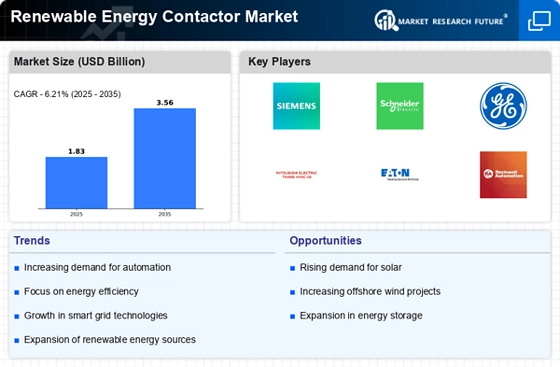Rising Environmental Concerns
The Renewable Energy Contactor Market is also propelled by rising environmental concerns among consumers and businesses alike. As awareness of climate change and its impacts grows, there is an increasing push for cleaner energy solutions. This societal shift is leading to a greater emphasis on renewable energy sources, which in turn drives the demand for contactors that can support these systems. Market analysis suggests that the increasing focus on sustainability will likely result in a 20% rise in the adoption of renewable energy technologies over the next decade, thereby creating a robust market for renewable energy contactors.
Government Incentives and Policies
The Renewable Energy Contactor Market is significantly influenced by government incentives and policies aimed at promoting renewable energy adoption. Various governments are implementing tax credits, grants, and subsidies to encourage investments in renewable energy infrastructure. For instance, the introduction of feed-in tariffs and renewable portfolio standards has stimulated the growth of renewable energy projects, leading to an increased demand for contactors that can handle the specific requirements of these systems. As a result, the market for renewable energy contactors is expected to expand, with projections indicating a potential increase in market size by 15% over the next five years due to favorable regulatory frameworks.
Increasing Demand for Renewable Energy
The Renewable Energy Contactor Market is experiencing a surge in demand driven by the global shift towards sustainable energy sources. As countries strive to meet their carbon reduction targets, the adoption of renewable energy technologies such as solar, wind, and hydroelectric power is accelerating. According to recent data, the renewable energy sector is projected to grow at a compound annual growth rate of over 8% in the coming years. This growth necessitates the use of advanced contactors that can efficiently manage the increased load and ensure reliable operation of renewable energy systems. Consequently, manufacturers are focusing on developing innovative contactor solutions tailored for renewable applications, thereby enhancing their market presence.
Technological Innovations in Energy Management
Technological innovations are reshaping the Renewable Energy Contactor Market, as advancements in energy management systems and smart grid technologies become more prevalent. The integration of Internet of Things (IoT) devices and artificial intelligence in energy management allows for enhanced monitoring and control of renewable energy systems. This trend is likely to drive the demand for sophisticated contactors that can seamlessly integrate with these technologies. Furthermore, the development of smart contactors that offer real-time data analytics and predictive maintenance capabilities is expected to revolutionize the market, providing end-users with improved efficiency and reliability in their renewable energy operations.
Growth of Electric Vehicles and Charging Infrastructure
The Renewable Energy Contactor Market is witnessing growth due to the expansion of electric vehicles (EVs) and the corresponding charging infrastructure. As the adoption of EVs accelerates, there is a growing need for renewable energy solutions to power charging stations sustainably. This trend is expected to create a substantial demand for contactors that can efficiently manage the electrical loads associated with EV charging. Projections indicate that the market for EV charging infrastructure will grow by over 25% in the next few years, further driving the need for reliable and efficient renewable energy contactors to support this burgeoning sector.


















Leave a Comment